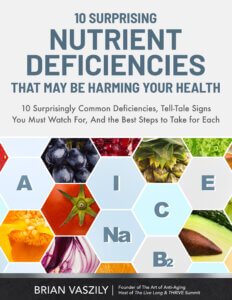Clothing is more than a fashion statement. It’s also a potential source of thousands of chemicals, some of which are extremely damaging to your health.
Some estimates put the number of chemicals commonly used in the fashion industry at around 8,000. And unfortunately, there is not much regulation surrounding which chemicals can and can’t be used, nor standard safety testing for potential long-term health effects.
This has led to a very disturbing situation:
There are likely toxins in your clothing right now that have the potential to cause cancer, hormone disruption, liver damage, and more.
And you probably don’t even know of their existence.
However, there is some good news.
While it’s difficult to avoid all chemicals in clothing, there are steps you can take to drastically cut your exposure by avoiding specific fabrics and fabric treatments and choosing better options.
Let’s look at the top fabrics to avoid (and why), plus how to make better choices to lower your contact with health-harming toxins.
Top Fabrics That Contain Health-Harming Chemicals
Conventional Cotton: Pesticides & GMOs
 Cotton is a natural fiber that has a lot going for it — breathability, durability, etc. — but not when it’s conventionally grown and sprayed with pesticides and herbicides.
Cotton is a natural fiber that has a lot going for it — breathability, durability, etc. — but not when it’s conventionally grown and sprayed with pesticides and herbicides.
Many conventional pesticides and herbicides are highly toxic and have increasingly been linked to health problems like hormone disruption, cancer, respiratory issues, and developmental problems.
There’s growing awareness of the dangers of pesticides used on the food we eat, but most people are not as aware of the amount of chemicals used in the “natural” clothing they wear.
Cotton can be particularly hazardous to your health because it’s one of the largest GMO crops in the world. For those who wish to avoid GMOs, this is bad in itself, but it gets worse…
There are two main types of genetically modified cotton.
One type makes the cotton more resistant to a pest known as the bollworm, and the second makes it resistant to glyphosate-based herbicides (the widely used chemical that has now been linked to cancer).
This means that the second type of GMO cotton crop is specifically engineered to have more glyphosate sprayed on it — more of a potentially cancer-causing chemical!
Unfortunately, this means that conventional cotton can be very toxic and not something you want near your skin.
What to Choose Instead
Opt for organic cotton clothing. Choosing organic materials for clothing doesn’t just benefit the environment, but it’s also great for our skin. Organic fabrics are known for being more hygienic, making them a smart choice for underwear and socks, which are in direct contact with our skin. Opting for organic options like women’s cotton socks or bamboo underwear for kids reduces the chances of irritation and discomfort, ensuring a better experience overall.
Waterproof Fabric: “Forever Chemicals” (PFAS)
 Waterproof or water-resistant clothing may contain a number of chemicals, including some known as “forever chemicals.”
Waterproof or water-resistant clothing may contain a number of chemicals, including some known as “forever chemicals.”
Per- and polyfluoroalkyl substances (PFAS) are widely used chemicals that were nicknamed forever chemicals because of how long they can persist in the environment (some can last for thousands of years).
You’ll also sometimes see them called perfluorochemicals (PFCs), which is an older name for the same chemical group.
They became extremely popular with manufacturers of a large number of products because they could resist water, heat, and stains.
The downside is that studies have linked various PFAS prostate, kidney and testicular cancer, reproductive issues, hormone disorders, liver damage, developmental problems, reduced immune response, and ulcerative colitis.
Due to these damaging findings, certain PFAS (particularly PFOA) have been phased out, but other chemicals from the same family are still used, especially in waterproof outdoor gear.
What to Choose Instead
If you absolutely need waterproof or water-resistant clothing, look for those labeled PFAS-free. Several brands now make this type of gear, and hopefully, more will soon catch on to the trend of cleaner waterproofing.
Blue Jeans and Dark Dyed Clothing: Azo Dyes
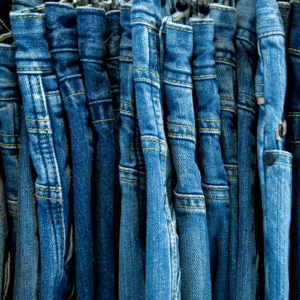
Azo dyes are the most commonly used synthetic dyes not only in the clothing industry, but also in printing, paper manufacturing, food, cosmetics, and other industries.
You’ll come across them in a number of different fabrics (even natural fibers that have been dyed synthetically), but they are most commonly used for blue denim clothing and will be most concentrated in dark blue, black, or brown clothing.
Azo dyes tend to be water-soluble, which is why clothing that contains them often has a warning to avoid washing them with easily stained clothing the first one to two times.
Unfortunately, this also means that the dye chemicals can easily come off on your skin and have more potential to be absorbed into your body.
This is a problem because azo dyes can cause skin irritation for those who are sensitive to the chemical p-phenylenediamine.
More significantly, certain types of azo dye release chemicals known as amines, which are carcinogenic (cancer-causing). Even some that don’t release amines have been labeled potentially carcinogenic.
This has led the EU to ban certain azo dyes that are known to release carcinogenic amines, but they are still used in the U.S. and other countries.
What to Choose Instead
Azo dyes are typically most concentrated in dark-colored clothing, so choosing lighter shades can limit your exposure. Also, begin to look for clothing that is undyed or naturally colored with plant-based dyes.
Leather Jackets, Etc.: Chromium
 Real leather products are made from animal hides by a process known as tanning. The hides are put through a variety of treatments to make them more durable, more pliable, and more water-resistant.
Real leather products are made from animal hides by a process known as tanning. The hides are put through a variety of treatments to make them more durable, more pliable, and more water-resistant.
Historically, the processing of leather largely relied on the use of tannins, which were acidic compounds naturally derived from the bark of certain trees. This is where the name “tanning” came from.
However, times have changed and most leather is now treated with chemicals known as chromium salts.
Hexavalent chromium is a specific type of chromium used widely in leather tanning and other industrial processes. It is very toxic to human health and is a known human carcinogen.
Coming into contact with hexavalent chromium can cause skin irritation (and worse), and it’s even more hazardous for those who work with it, potentially causing lung, nasal, or sinus cancer, kidney and liver damage, skin ulceration, and eye damage.
Some leather products were even banned from entering the EU in 2014 because they contained chromium, “a skin-sensitizing substance,” but it’s unfortunately still in use elsewhere.
What to Choose Instead
It’s certainly best for your health, the environment, and animals, too, to avoid leather altogether. If you must have it, look into vegetable-tanned leather or naturally-tanned leather products that still use tannins instead of chromium. Especially avoid leather clothing made in China as it has been found to contain high levels of chromium in the past.
Faux/Vegan Leather and Activewear: Plasticizers & Phthalates
For those who don’t want to wear real animal leather, vegan leather is an attractive alternative, but it has a very misleading name.
The word “vegan” in the name gives the impression that faux leather is “healthy” and non-toxic, but this is usually far from the truth.
Most types of vegan or faux leather are made from plastic polymers, mainly polyurethane (as in the case of PU leather) and polyvinyl chloride (PVC).
You do not want either of these plastics to be in contact with your skin for long periods of time.
Plastics are known to contain various endocrine-disrupting chemicals, especially a type known as phthalates. You may have heard of phthalates because they are everywhere (shower curtains, nail polish, steering wheels, etc.) and are a major contributor to toxin overload.

Studies have linked phthalates to hormone disorders, reproductive problems, asthma, allergies, AND increased cancer risk.
And unfortunately, vegan leather isn’t the only place you’ll find phthalates.
The comfortable activewear and sportswear that everyone loves are often made with plasticizers to make them softer and more durable, which means they are also full of phthalates and other hormone-disrupting chemicals.
What to Choose Instead
There are vegan leather options made out of natural materials like cork, although it takes a bit of searching to find them. Also, there are an increasing number of sustainable activewear brands that do not use plasticizers in their clothing — you just have to look for them.
Better Clothing Options + Tips for Finding Them
You now have an idea of just how many toxins could be lurking in your clothing and the top fabrics to watch out for.
The good news is that as awareness of toxic clothing slowly but surely grows, there are better fabrics available that may not have been there a decade or two ago. Even some major clothing brands are starting to clean up their manufacturing process.
Here are some key tips for how to educate yourself on cleaner clothing options and some of the least toxic fabrics to wear.
Read the Label Before You Buy
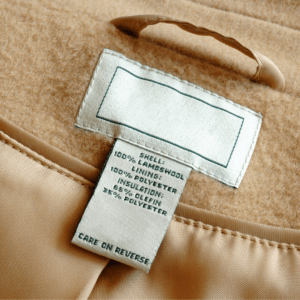
If you are a health-conscious person, you may be used to reading the labels on food products to determine whether they haveharmful ingredients in them.
Well, now is the time to also start reading your clothing labels and tags.
Of course, you won’t be able to read a list of all the chemicals that went into making a specific piece of clothing, but there are some key pieces of information to look for.
To start with, what fabric is the clothing made of? Is it natural, synthetic, recycled…?
Also, check the tags for key words like “stain-resistant,” “wrinkle-resistant,” and “waterproof” that indicate a piece of clothing is likely to be high in toxic chemicals. Avoid these when possible, or research the brand you are buying from to make sure the treatments are PFAS-free.
You can also check for positive descriptions like “undyed” or “naturally dyed.”
As much as possible, buy clothing that is free of plastic, which means avoiding synthetic fabric (particularly polyester), PU leather, and so on.
Choose These Fabrics Instead
Given how many chemicals are used to make any type of synthetic fabric, natural textiles are a much better choice.
There can still be issues with natural fibers (conventional cotton, for example, and sustainability issues with certain crops), but if you are just beginning to detoxify your wardrobe, natural fabrics are an excellent starting place.
Here’s a look at some top choices:
Organic Cotton
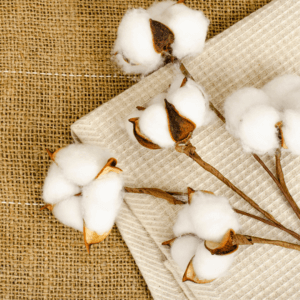
As mentioned earlier, cotton can be a high-quality, very breathable fabric as long as it doesn’t have chemicals from pesticide and insecticide residue. It can also be a very sustainable crop, although much work needs to be done in this direction.
According to the Textile Exchange, only about 22% of the world’s cotton is sustainable. They hope to raise this number to 50% by 2025, which would make organic cotton a much more eco-friendly and non-toxic clothing choice.
Hemp Fabric
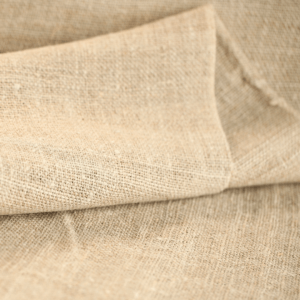 Hemp may just be one of the most sustainable crops on earth. Related to the marijuana plant but with no ability to get anyone high, hemp grows easily in many types of soil and naturally needs few to no pesticides or herbicides. This means that even non-organic hemp has a much lower toxic load than most other fibers.
Hemp may just be one of the most sustainable crops on earth. Related to the marijuana plant but with no ability to get anyone high, hemp grows easily in many types of soil and naturally needs few to no pesticides or herbicides. This means that even non-organic hemp has a much lower toxic load than most other fibers.
Hemp also requires only about half the water cotton needs in a growing season and can produce double the fiber yield of cotton in the same amount of growing space! The only “downside” to hemp is that it’s still a relatively new fabric due to a long-time ban in the U.S. on hemp products, but it’s slowly picking up steam.
Linen Fabric
 Linen may be considered an “old-fashioned” fabric — and indeed dates back to around 8000 BC! — but it deserves a comeback.
Linen may be considered an “old-fashioned” fabric — and indeed dates back to around 8000 BC! — but it deserves a comeback.
Linen is made out of fibers from the flax plant, which is another crop that naturally needs few pesticides or herbicides to thrive. These fibers produce a biodegradable fabric that is long-lasting when well-cared for and can hold up to a lot of use.
Bamboo Fabric
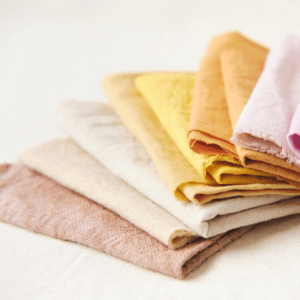
Bamboo is an extremely fast-growing crop that requires little water and no pesticides to thrive, which gives it a lot of potential for producing less toxic fabric. And while bamboo can be a great clothing choice, it comes with a few “buts”.
The biggest downside is that bamboo is a much tougher substance than cotton, hemp, or flax, which means it has to undergo much more processing to become a soft, comfortable fabric. This can mean a lot of chemical use, depending on which brand is making the clothing and what their standards are. So do a little research into the company you are buying from before choosing bamboo clothing.
Tencel
 Tencel, or Tencel lyocell, is actually a brand-name fabric that is quickly becoming an excellent alternative to some synthetic fabrics. It’s technically a type of rayon that uses sustainably grown wood pulp and a closed-loop processing system to cut down on harmful waste that might enter the environment.
Tencel, or Tencel lyocell, is actually a brand-name fabric that is quickly becoming an excellent alternative to some synthetic fabrics. It’s technically a type of rayon that uses sustainably grown wood pulp and a closed-loop processing system to cut down on harmful waste that might enter the environment.
Because the manufacturing process still uses chemical solvents, Tencel is NOT 100% non-toxic, but it is a much better choice than conventional rayon or viscose. Notably, it can be used in activewear to replace “plastic” fabrics as well as added to many other types of clothing.
Best Organic Socks On the Market: Q for Quinn
 If you are in the market for a truly organic, completely non-toxic clothing, opting for Q for Quinn socks is a great place to start.
If you are in the market for a truly organic, completely non-toxic clothing, opting for Q for Quinn socks is a great place to start.
As a GOTS-certified organic brand, they believe that quality products should not come at the expense of health — for our planet, for you, or for their manufacturers.
Made from Organic Cotton, Q for Quinn products are made from toxic-free dyes and materials that meet the highest global standards (GOTS). Plus, these socks are also held to the highest social and ethical standards, allowing the people who make them to earn a true living wage (not a minimum wage!)
Not only are these socks more comfortable than conventional ones, but they’re better for your skin health, too. Materials like Organic Cotton are far more breathable and gentle than synthetic fabrics, making them safe for even the most sensitive skin.
If you have looked for socks without polyester you would know how hard it is to find, but Q for Quinn minimizes the use of synthetics and pushes the boundaries by using natural fibers to achieve the same results.
Read more about Q for Quinn here for plant-based, non-toxic socks and more!

